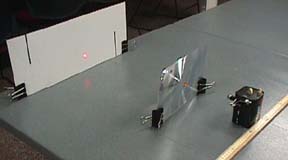Bending the Light fantastic

Bending the Light fantastic

Introduction
Lasers make a bright beam of light. Shine the beam through a large page-magnifier fesnel lens to show how the lens bends light to create images.
Material
A small low power laser such as a laser pointer.
A page magnifier fresnel lens
binder clips
cardboard with a white side to use as a screen
steel support, such as a dead lantern battery,
Refrigerator magnets
Straight edge or straight sided piece of wood.
masking tape
Assembly
Mount the fresnel lens on a table, clip two large binder clips to the bottom of the lens, then place the lens so that it is perpendicular to the table.

Mount the laser to a steel object with binder clips and magnets.
See Magnetic Optical
Bench.
Mount the laser so that its beam is parallel to the floor and shines
through the center of the fresnel lens.

Lasermagnetically attached to steel block with beam passing through the center of the fresnel lens
Tape down a straightedge or a piece of wood to the table parallel to the fresnel lens.
To Do and Notice / What's Going On?
Parallel beams shining into the lens come together at the focal point.
Slide the block of wood with the laser along the straight edge so that the laser goes through the fresnel lens. The point where the laser hits the lens will slide back and forth along a line parallel to the floor.

Use a white screen to observe the behavior of the laser beam on the opposite side of the lens.
Place the white screen very close to the lens. Slide the laser left and right. Notice that the spot of light on the screen also moves left and right.
The farther from the lens the screen is placed the less the beam moves side to side until, at one distance, the beam moves very little. This point is the focal point of the lens. Where parallel beams of light hitting the lens at different positions are bent so that they all come together at one point. Mark this point on a table using masking tape.
Beyond the focal point the beam moves opposite the motion of the laser.

Slide the laser to the side. The beam always bends toward the center of the lens.
Put the laser beam into the center of the lens. Locate the beam on the far side of the lens. The beam though the center goes in a straight line, it is not bent. The line perpendicular to the lens and through its center is the axis of the lens.
Move the laser to one side of center. Notice that the laser beam bends toward the axis of the lens.
Move the laser further to the side and it bends more. In fact, to make a beam that comes together as a focal point, the bending of the beam must be proportional to the distance from the center. (This proportionality is true for small bending angles otherwise the angle is the arctangent of the displacement divided by the focal length.)
Remove the straightedge.
Beams radiating from the focal point exit the lens parallel to each other.
Mount the block with the laser on it so that the center of the laser rotates about the focal point of the lens. (For example, pivot the laser block on a magnet stuck on the top of a steel battery case turned sideways.)


Notice that as the laser is rotated, the beam comes out from a point just as light does when it radiates from a normal bulb. However the laser allows us to examine one ray of light at a time.
On the far side of the lens the beam moves back and forth the same amount independent of the distance from the lens to the screen. The rays coming out of the lens are parallel. This will only be true if the laser pivots about the focal point of the lens.
Beams radiating from other points come together at an image point.
Rotate the laser about points other than the focal point.
Rotate it about a point further from the lens than the focal point and the light comes back together not at the focal mpoint but at another point called the image point.
Rotate the laser about a point closer to the lens than the focal point and the light never comes back together again.
Place the front of the laser so that it touches one point on the lens. Rotate the laser about the point at which it touches the lens.The laser beam hits the same point on the lens at different angles. Notice that when the laser hits the lens at the same spot, the beam always bends toward the axis by the same amount.


A point on the fresnel lens will always deflect initial direction of the laser beam (dashed line) toward the axis of the lens by the same angle, regardless of the angle with which the light hits the lens.
Etc
One way to think about lenses is that they turn the position at which a beam hits them into an angle of deflection, and that they turn the angle with which a beam hits the lens into a position in the focal plane.
|
Scientific Explorations with Paul Doherty |
|
21 Feb 99 |